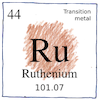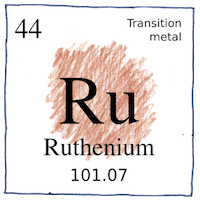Kazan—Karl Ernst Claus
elements

|
Ruthenium
Starting in 1840, Karl Ernst Claus worked with platinum ore from the Saint Petersburg mint to study the chemistry and isolation of rhodium, iridium, osmium, palladium, and platinum. In 1844, he discovered a new element in the insoluble residue from crude platinum, determined its atomic weight, and described its properties. He named it after Ruthenia, the Latin name for where he was born.
Atomic number 44
Wear-resistant electric contacts, thick-film resistors, fountain-pen nibs, jet-engine turbine blades, dust for showing fingerprints, red stain for microscopy, catalyst for removing sulfur from oil.
Parker 51
In the evening I filled the pen with ink. Throughout the day its ink flowed out. Its ink traced my life’s outline. In the evening I filled the pen with ink again. * My ink flowed through a ruthenium nib. Silently, gracefully. Without stopping, without blotting.



My Parker 51 fountain pen had the ruthenium nib.
See also in The book of science:
Readings in wikipedia:
Other readings: